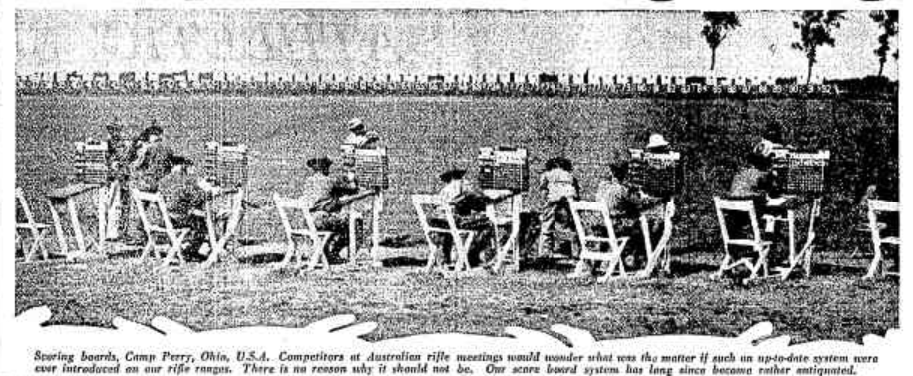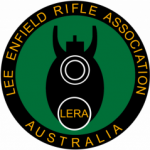by Aubrey Spencer
Practice will Improve your Standard
In today’s issue, Dr. A. W. L. Row, of Toowoomba, Qld, takes the enterprising rifle shooting student yet another step along the pathway which leads to a better understanding of the principles governing the correct use of the single-arm sling. The reasons advanced are based on a sound scientific principle, but are nevertheless, clearly outlined in simple language intelligible to all. This, and the concluding article which will appear next week, complete a series well worth the careful study of both novice and experienced riflemen.

Even those to whom the single-arm sling is nothing new, will be able to sift out some useful hints which will, if studied, practised, and put into operation, further improve their existing standard of marksmanship.Dr. Row has apparently approached the problem from every conceivable angle, and if the tyro should happen to meet with some puzzling feature, it is felt that a solution of such will be found in some part of his contribution. Because of this fact, don’t trust to memory. Paste the whole series of articles in your scrap-book, and have a valuable reference work at your command.
The correct placing of the left elbow is very important; it is not placed directly under the rifle, but in front of the left shoulder, and thus slightly to the left of the rifle; this position gives a feeling of easy support for the rifle, and of adequate steadiness against any tendency to wobble laterally. Its position once chosen with reference to that of the left shoulder and hips, should be kept constant most carefully, for upon it will depend the bracing of the left shoulder as well as the height of the rifle and hence of the shoulders. The optimum shoulder height and hence left-hand height and position for the left elbow having been determined in that order, the approximately correct length of the sling can now be arranged, and some snapping practice done in order to secure a really fine adjustment of its length — remembering to wear the same clothing on the left upper arm as when shooting. Its final adjustment should be such that, with the chosen position for hips, shoulders,left elbow and left hand grip, a definite firm (though not heavy or fatiguing) thrust forward of the left hand from the elbow is needed in order to bring the muzzle down to target level when the butt is correctly placed on the right shoulder; the progressive tightening of the sling finally checks this movement before any discomfort occurs in the left hand or forearm.
DO NOT GRIP TIGHTLY
The left hand docs not grip tightly with the fingers, but the sling as it passes beneath the back of the wrist and hand presses the palm up against the under surface of the fore-end, and the friction there prevents the hand from slipping forward, while the fingers clasp the fore-end quite loosely. When the rifle is held correctly, it will lie quite upright without any cant along the palm of the left hand, without the need of being gripped or twisted by either hand; in other words, the hand grips are not needed, nor advisable, to prevent canting. In tightening the correct sling length, then, the left arm feels to be pushing the rifle as far towards the target as the tightening sling will allow with absolute comfort, the muzzle lowering gradually as the sling tightens.The position of right elbow is chosen after the shoulder is pressed forward in firm contact with the butt. It has no sling support to prevent it sliding outwards, or jumping at the movement of recoil. Hence its firmness must be regulated by muscular action. It should be placed well forward, e.g., two inches in front of the butt, and no further away from the right side than is necessary to secure the desired height of right shoulder and a comfortable as well as firm right hand grip on the small. The relative positions of right and left elbows will vary with the individual’s breadth of shoulders,length of arms and height of shoulders; sis an example, however, one thickset man with arm spread of 69 inches finds the best position for tho right elbow to be about 10 inches behind and 11 inches to the right of the left elbow, and about 2 inches in front of the butt.
BRACING OF RIGHT SHOULDER
The muscular bracing of the right.shoulder and elbow at first causes some difficulty; the first point to emphasise is that the butt is not pulled back to the shoulder, but that the shoulder is thrust forward into close contact with the butt; this Is effected by the contraction of the muscle joining the front of the chest to the upperarm (‘pectoralis major’), and also by a large muscle which pulls forward the shoulder blade on the chest wall. This muscular contraction not only braces the shoulder in its forward position, but also provides a muscular pad on which the lower half of the butt, including the toe rests, viz. the outer end of the pectoralis close to its insertion into the bone of the upper arm. A trial will show that the contraction or tightening of this muscle raises the butt and hence lowers the muzzle since the left hand support remains fixed, and any increase of tightening at the moment of firing will lead to a low shot, which cause will be masked by the recoil, such an increase is very liable to occur in anyone who is ‘waiting for’ the recoil, and who involuntarily braces the shoulder a little tighter just as the trigger is pressed; it is probable that many low shots, either unexplained or attributed to ‘wind’ are due to this cause. There should be no unpleasant ‘kick’ when the rifle is held properly and tho body weight, as well as the left hand thrust well forward, but merely a steady thrust by no means uncomfortable. Thus it is evident that the pectoralis muscle must not only be braced firmly, but uniformly from shot to shot, and that this bracing must be maintained unaltered until the recoil is finished. Much stress is always laid upon not pulling the shoulder away to avoid the kick, but trouble also can be caused by pushing it up a little harder as the rifle is fired.The thrusting forward of the right shoulder must not be allowed to cause any pulling back of the left shoulder, or unsteadiness will result.The bracing of the right elbow in its chosen position is now secured by pressing the right palm firmly against the small, as though pushing the butt well into the junction of neck and shoulder, the pressure being exerted from the right shoulder, and thus tending as well to pull the elbow in towards the body; it is as though the whole bent arm was being thrust across the front of the body from the shoulder,and not merely the hand being revolved round a fixed right elbow position on the ground. It is the pectoralis major again which exerts most of this pull, and hence right elbow bracing as well as right shoulder bracing influences steady pressure on the butt. The pull exerted, though very definite, is not by any means strenuous or tiring, and like the shoulder bracing, must be as uniform as possible from shot to shot — an additional reason for not changing the elbow position during a shoot. This right hand pressure tends to push the muzzle over to the left, since the butt is fixed, but this can be easily counteracted by a gentle thrust to the right of the left hand on the fore-end, acting chiefly through the thumb, a very easy fine adjustment.
THE RIGHT HAND GRIP
The right hand grip steadies the butt on the shoulder, and also when it is correctly applied prevents the trigger pressing from disturbing the aim. It is a much firmer grip with fingers and thumb than the left hand, but must not be so firm as to cause any discomfort.The fingers are first wound round the undersurface of the small, and the thumb then wound round its upper surface. placing fingers and thumb with great care to secure absolute comfort as well as firmness of grip. The heel of the palm as well as its front half should be kept pressed against the small, and the ball of the right thumb especially pressed down and towards the left; this palm and thumb pressure is very important, as it prevents the muzzle from moving out towards 9 o’clock as the trigger is pressed; such movement is a very common fault with a single arm sling, and it is often obscured by the recoil; (another cause of this wandering to the left lies in a momentary lessening of the firm forward thrust of the left hand, i.e. a slight slackening of the sling). The right hand also exerts a slight forward pull on the shoulder,thus keeping the shoulder pressing uniformly on the butt; the arm biceps chiefly exert this pull.


